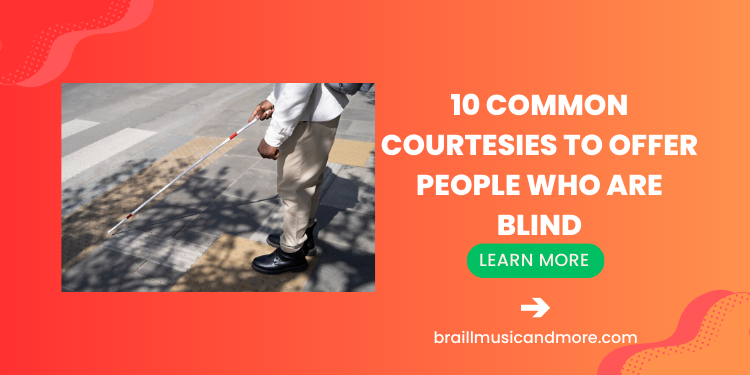It’s critical to show consideration and empathy for all individuals, including the blind and visually impaired. Small acts of kindness can go a long way toward making their lives comfortable and inclusive.
The ten common courtesy gestures listed below can be used to show blind or visually impaired people in order to foster an accepting and compassionate community.
1. Offer Assistance, but don’t make them feel dependent
If you know someone or see someone who is blind, don’t hesitate and offer them assistance.
While helping someone out is a nice gesture, it’s also crucial to respect their independence. When offering assistance, do so in a courteous manner and be clear about what you’re offering.
For instance, you can just ask, “Would you like some assistance finding the elevator?” as an example. By doing this, you are granting them the choice to accept or reject without assuming anything about their capacity.
2. Greet and Identify Yourself
When approaching someone who is blind, it’s essential to greet them and let them know you’re there. Say hello and identify yourself by name.
This simple act gives them important information about who you are and sets the stage for a comfortable interaction.
3. Guide, Don’t grab
If the person accepts your assistance, it’s important to guide them rather than grabbing or pulling them.
Offer your arm for them to hold onto and walk slightly ahead. This allows them to follow your movements and maintain their own sense of direction.
4. Be mindful of Personal Space
Respect their personal boundaries when assisting someone who is blind. Avoid standing too close and don’t touch without their consent.
Remember they have the same right to personal space as everyone else
5. Describe the Environment
When interacting with someone who is blind, provide them with information about their surroundings.
Mention landmarks, obstacles, or important details that can help them form a mental map of the area. This empowers them to move with confidence.
6. Use Inclusive Language
When conversing with someone who is visually impaired, it is natural to use phrases that involve visual references.
However, be mindful and find alternatives to convey the same. For example, instead of using “over there” or “across the street” provide clear instructions like “to your right” or “opposite the library.”
7. Be Patient and Allow Extra Time
Navigating the world without sight may take a bit more time and effort. Be patient and don’t rush someone who is blind when interacting with them. In case you’re in a group setting, allow them to adjust to the surroundings.
When they walk together, also let them dictate the pace. Ask if they want you to take the lead if they need help, but don’t forget to consider their comfort level and preferences at all times.
8. Offer Assistance When Crossing Streets
Crossing streets can be a particularly challenging aspect of daily life for individuals with visual impairments. If you’re with someone who is blind When it’s time to cross a street and you’re with a blind person, offer to help them by giving them precise instructions. You could state, “The traffic light will turn green at the crosswalk just ahead.
Always remember to inform them of any potential obstacles or changes in the environment, such as uneven terrain or construction.
9. Foster Inclusivity in Group Conversations
Making sure that everyone in a group feels heard and included is crucial. To let the person who is blind know you are speaking to them specifically, call out their name when you speak.
Take a moment to explain any visual elements you’re talking about so they can follow along and join in on the discussion.
You’re encouraging inclusivity and a sense of belonging by actively involving them, and this is essential to fostering a polite and encouraging atmosphere.
10. Promote Accessibility in Communication
Incorporate accessible communication methods when interacting with individuals who are blind or visually impaired.
Consider providing information in alternative formats, such as braille or audio, to ensure they have access to the same information as everyone else.
This proactive approach not only demonstrates thoughtfulness but also contributes to creating an environment where everyone can participate fully and independently.
By embracing accessible communication, we reinforce the commitment to inclusivity and make strides towards breaking down barriers for individuals with visual impairments.
Conclusion
The lives of those who are blind can be greatly improved by showing consideration and providing these basic courtesies. It all comes down to acknowledging their distinct experiences and making tiny changes that will contribute to a more welcoming and inclusive world for all.
Remember, a little kindness and understanding can go a long way in creating a more empathetic and inclusive society. Let’s work together to ensure that everyone, regardless of their abilities, feels valued and respected.
Contact Braille Music and More today for Braille Services!







